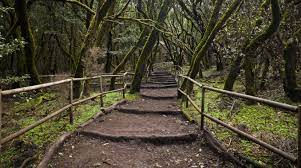


Roque Negro
Roque Negro is a small traditional hamlet in Anaga Rural Park. Surrounded by lush forests and ravines, it preserves the typical Canarian architecture of whitewashed houses and tiled roofs. This quiet village reflects the rural way of life that has endured for centuries in Tenerife, offering a haven of peace and authentic nature.


Montaña Amarilla
Montaña Amarilla, on the south coast of Tenerife, is a protected natural area formed by ancient volcanic eruptions that gave rise to spectacular layers of gold and ochre. Its cliffs and coves offer crystal-clear waters ideal for swimming and snorkeling, with a great marine diversity. It is a peaceful and photogenic spot where geology, the sea, and silence combine to create a unique landscape.


Charco los Chochos
Charco Los Chochos, in Los Silos, is a natural saltwater pool formed by ancient volcanic lava flows that jut into the Atlantic. Its quaint and picturesque name comes from the local custom of soaking chochos (lupins) in seawater. It's an ideal place to swim, relax, and enjoy the views of the imposing Teno Massif and, on clear days, Mount Teide.


Ballena de los Silos
On the Los Silos promenade, facing the Atlantic Ocean and with the Teno Mountains as a backdrop, stands the lifelike skeleton of a fin whale, the second largest species on the planet. This impressive outdoor structure not only impresses with its size and photogenic appeal, but also acts as a reminder of the Canary Islands' rich marine biodiversity and the island's historical connection to the ocean.


Punta de Teno
Punta de Teno, the westernmost tip of Tenerife, offers unspoiled landscapes, impressive cliffs, and unparalleled views of Los Gigantes and La Gomera. It's one of the wildest and most unspoiled corners of the island.


Caserio de Icor
The picturesque hamlet of Icor is a small rural complex declared a Site of Cultural Interest, featuring whitewashed stone houses, sloping roofs, and a traditional granary built on tuff columns. Its walls tell stories of peasant families, traditional Canarian architecture, and deep roots dating back to Guanche settlements.


Museo De Las Ilusiones
In the historic building of a former tobacco factory in the center of Santa Cruz de Tenerife, you'll find the Museum of Illusions: an interactive space where science, art, and entertainment come together to test your senses. Over 700 m² of optical illusions, inverted rooms, dancing shadows, and mind games challenge your perception with humor and surprise.


Centro Alfarero y Museo Etnográfico Cha Domitila
The Cha Domitila Pottery Center, in Arguayo, is a living museum of traditional Canarian pottery with direct roots in Guanche culture. Here, artisans reproduce ancestral techniques without a wheel or glaze, inherited from pre-Hispanic potters, creating pieces such as gánigos and bernegales. A space where indigenous memory is kept alive through clay.


Museo de Historia y Antropología de Tenerife - Casa Lecardo
Casa Lercaro is an elegant 16th-century Mannerist mansion in La Laguna. Today it houses the Museum of History and Anthropology of Tenerife. Its façade is a beautiful example of Genoese architecture, with decorative sgraffiti and an interior courtyard with stone and wood galleries that reflect the Canarian stately style.


Ermita de San Blas
Discover a corner steeped in history and spirituality on the Candelaria coast. The Hermitage of San Blas houses a cave that was once a sacred place for the ancient Guanches, an ancestral space where myth and devotion intertwine. It's a peaceful, uncrowded spot, ideal for connecting with Tenerife's deep roots away from the hustle and bustle of tourism.


La casa de los balcones
The Casa de los Balcones is a 17th-century gem in La Orotava: a façade with balconies carved from Canary Island pine, a green interior courtyard, and artisan workshops. A place where you can admire the mastery of Canary Island fretwork and feel the living pulse of island traditions in a historic and welcoming setting.
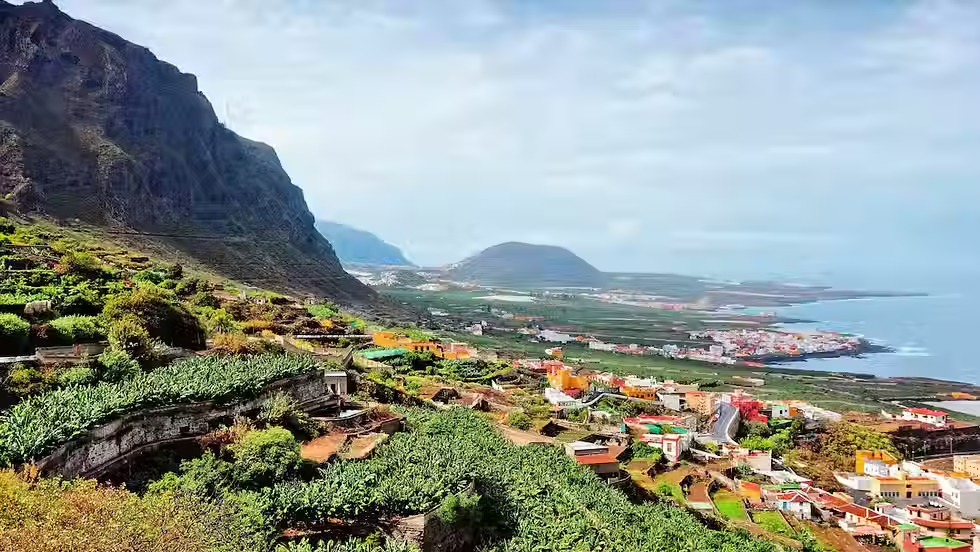

Buenavista del Norte
Buenavista del Norte welcomes you with verdant ravines, a wild coastline, and villages where time passes slowly. Ideal for hikers, surfers, or those seeking peace without posturing. Here, rural life coexists with the rough sea and a profound culture. There are no crowds, but there are viewpoints, secret pools, and a feeling of being in the "other" Tenerife: the one few know about.
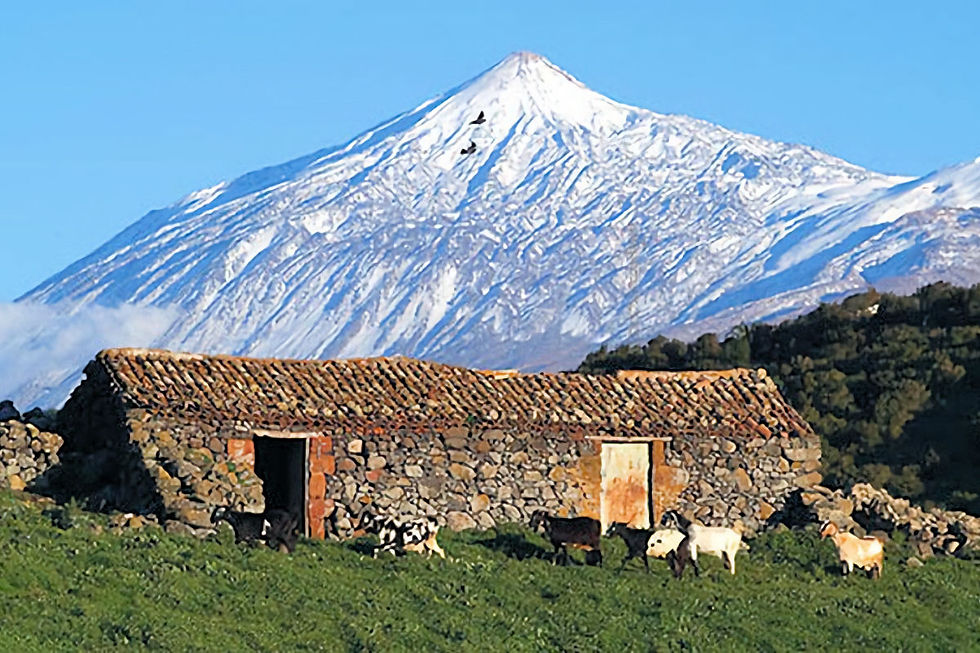

Teno Alto
Teno Alto is a rural paradise in the Teno Mountains where impeccable goat cheeses are made. Surrounded by nature, artisans open their doors for you to watch as they milk, make, and mature fresh, semi-cured, and cured cheeses with a volcanic character. An authentic, artisanal, and flavorful experience that connects with the most authentic island cuisine.


Chirche
Chirche is a small rural treasure nestled in the midlands of Guía de Isora. Its stone houses, cobblestone streets, and old ovens tell stories of the island's agricultural past. From here, you can enjoy epic sunsets over the sea and La Gomera. If you're looking for peace, authenticity, and a stroll through living history, this place is a gift.


Afur
Afur is a hamlet surrounded by ravines, wild vegetation, and silence. Perfect for getting lost among trails that lead down to the sea, hidden caves, and natural pools. From here, you can explore routes that combine forest, rocks, and ocean in a single day. This is Tenerife at its purest and least touristy.


Chamorga
Chamorga is a village lost in the mountains, where the road ends and the adventure begins. It's the ideal starting point for hikers looking to explore the green and rugged landscapes of Anaga Rural Park. Here, everything is quiet, with ancient paths and a clear sky that seems closer. If you like the remote, this is your place.


El Sauzal
El Sauzal is one of those towns that surprises you without making a fuss. Canarian balconies, quiet plazas, and stunning views of Mount Teide and the ocean from almost every corner. Ideal for a leisurely coffee, exploring natural viewpoints, and enjoying one of the most beautiful sunsets in the north. Here, everything is clearer... and life is slower.


Taganana
Taganana is nature in its purest form: a picturesque hamlet nestled between rugged mountains and ravines that descend to the Atlantic. Here, everything is green, rocky, and authentic. Ideal for unwinding, tasting fresh fish by the sea, and experiencing the island's wildest side. If you love rural landscapes, history, and stunning landscapes, this is the place for you.


Los Cristianos
Los Cristianos is sun, sand, and atmosphere year-round. A former fishing village converted into one of the liveliest tourist centers in southern Tenerife. Here you can swim, eat with sea views, take a ferry to La Gomera, or simply stroll along its lively promenade. Perfect for those looking for the sea, services, and convenience without the hassle.


San Juan de la Rambla
San Juan de la Rambla is one of those northern towns that seem frozen in time. Between cliffs, old houses, and cobblestone streets, this coastal haven offers tranquility, history, and spectacular views of the Atlantic. It's ideal for strolling, admiring the sea, and tasting good Canarian food away from the hustle and bustle of tourism.


Santiago del Teide
Santiago del Teide combines rural tranquility with picture-postcard volcanic landscapes. It's the perfect spot for those who want to explore the heart of the island, amidst almond blossoms, Teide trails, and charming villages. Its historic center is small but authentic, surrounded by nature, tradition, and fresh air. Ideal for unwinding without missing out on the essentials.


Icod de Los Vinos
Icod de los Vinos vibrates with history, nature, and fine wine. Its iconic landmark is the ancient dragon tree, a hundred-year-old tree surrounded by gardens, while its old town boasts cobbled plazas, fountains, and traditional houses with balconies. There are also family-run wineries, nearby beaches, and volcanic caves to explore. A place with soul.


ARTLandya
ARTlandya is a magical museum in Icod de los Vinos, where doll art blends with a tropical garden. More than 600 dolls and teddy bears create unique atmospheres in a charming estate. Perfect for families, children, or those curious about miniature art. A surprising visit without the large crowds.


La Caleta
La Caleta is a picturesque fishing village in southern Tenerife, with traditional boats, whitewashed houses facing the Atlantic, and a peaceful atmosphere. Famous for its seaside seafood restaurants and sunsets over La Gomera, it offers swimming in crystal-clear waters from protected rocks. Ideal for those seeking local flavor without the crowds.


Puerto de la Cruz
Puerto de la Cruz was a pioneer in Tenerife tourism, and today it's vibrant yet still charming. Its center revolves around the Plaza del Charco, surrounded by palm trees and cafes. Stroll through picturesque alleys, admire Loro Parque, relax in the pools of Lago Martiánez, and enjoy the historic coastal atmosphere overlooking the Atlantic.


Candelaria
Candelaria is a coastal town on the Atlantic coast and home to the Basilica of the Virgin of Candelaria, patron saint of the Canary Islands. With traditional ceramics, seaside walks, and Guanche statues in front of the church, it is a spiritual and cultural place, ideal for strolling through history and devotion with an island seafaring flavor.


Masca
Masca is a magical village in northwestern Tenerife, nestled between steep cliffs and verdant vegetation. With just a handful of cobblestone streets, its traditional architecture and views of the Atlantic add charm. The starting point for the ravine route, it combines Guanche history, local cuisine, and breathtaking panoramic views.


Vilaflor de Chasna
Vilaflor is a rural village perched at an altitude of 1,400 meters in the heart of the Corona Forestal, surrounded by centuries-old pine forests and fields of vineyards and almond trees. Its traditional architecture, featuring balconies and old windmills, evokes a sense of island authenticity. It is famous for its high-altitude wine and for being the birthplace of Brother Pedro, the first Canarian saint.


La Orotava
La Orotava is a stately town in the Orotava Valley, surrounded by banana plantations and views of Mount Teide. Cobblestone streets, carved wooden balconies, lively plazas, and historic gardens. Breathe in history in its colonial architecture as you stroll among museums, cafés, and pure Canarian charm.


Garachico
Garachico is a charming coastal town surrounded by history and volcanic nature. It boasts cobblestone streets, palm-fringed plazas, stately homes, and natural pools formed by lava. Elegant and resilient, it has reemerged from disasters and today offers a peaceful atmosphere, ideal for strolling, having a drink, and enjoying the Atlantic with its island flavor.


Palmetum Tenerife
The Palmetum is a 12-hectare urban botanical garden specializing in palm trees: more than 600 species, waterfalls, ponds, and viewpoints overlooking the Atlantic. Founded in 1995 on a recycled landfill, it now impresses with its biodiversity, views, and sustainable environment, ideal for leisurely strolls amidst the green shade and sea breeze.


Auditorio de Tenerife
With its white silhouette, curved like a giant wave, the Tenerife Auditorium is the modern icon of Santa Cruz. Designed by Santiago Calatrava, it hosts concerts, opera, and cultural events overlooking the sea. Its architecture is striking from afar, but it's best to experience it from within. Culture, design, and views all in one.
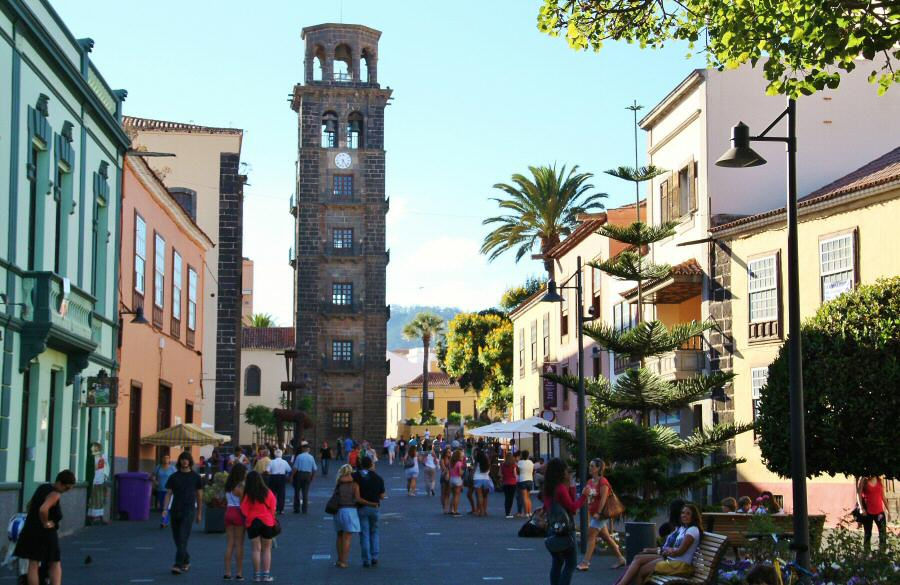

Centro historico de La Laguna
Cobblestone streets, colonial mansions, and colorful facades: the historic center of La Laguna is a leisurely journey through the first colonial city without walls. A UNESCO World Heritage Site, its Renaissance layout is an urban gem where history and local life blend amid charming cafes, museums, and bookstores. Here, every corner holds a story.


Castillo de San Juan Bautista (Castillo Negro)
The Castillo de San Juan Bautista, popularly known as the Black Castle, is a circular fortification of volcanic walls built between 1641 and 1644 to protect the port. It is located next to the César Manrique Maritime Park and across from the Auditorium. Although it is not accessible, its well-preserved exterior is easily visible from the shore.


Castillo de San Cristóbal
San Cristóbal Castle was the main fortress of Santa Cruz from its construction in 1575 until its demolition in 1928. Today, only archaeological remains remain, visible beneath the Plaza de España, in an underground visitor center. Also on display is the famous "El Tigre" cannon, which, according to tradition, wounded Admiral Nelson in 1797.


Playa de los Roques
Los Roques Beach is a wild volcanic cove brimming with charm. Black sand mixed with pebbles, and two giant rocks emerge from the sea like natural sculptures. Barely 350 meters long and with no services, the beach has a very peaceful atmosphere. You can reach it by walking along the water path from Rambla de Castro. Strong waves: ideal for viewing, not for swimming.


Escultura de la Giganta
The Giantess is a monumental sculpture measuring approximately 4m in the La Quinta Social Garden in Santa Úrsula. It represents a reclining woman adorned with plants that create a vertical garden effect on her body. It's ideal for photos; it's located at street level with nearby parking, free access all day, and, as a bonus, you can see Mount Teide in the background on clear days.


Iglesia Vieja de Fasnia
The Old Church of Fasnia is a minimalist ruin of the former Hermitage of San Joaquín, built in the 17th century. Today, all that remains is a semicircular arch on a couple of walls, but it stands high on a hill overlooking the ravine and the rural landscape. Surrounded by silence and nature, it is a peaceful and charming place to escape for a few minutes.
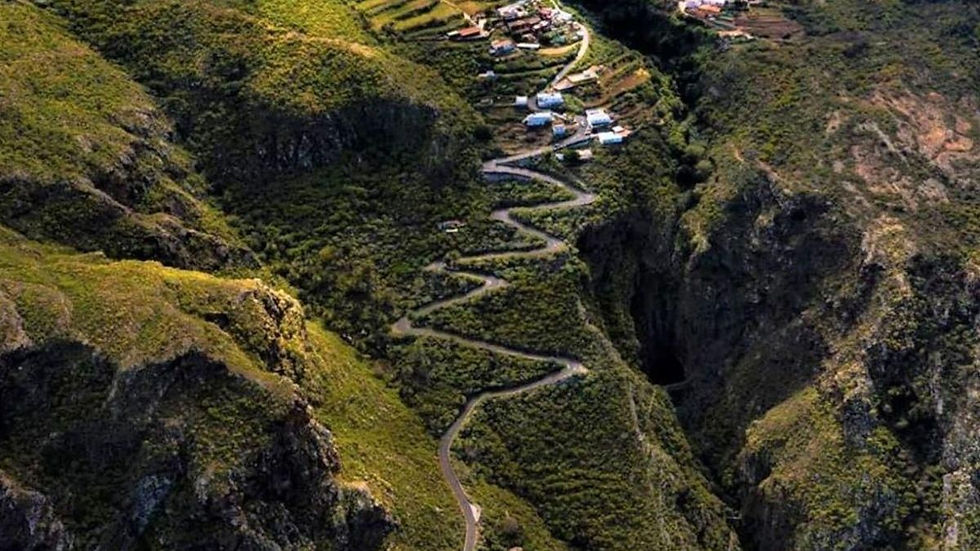

Tierra del Trigo
Tierra del Trigo is a small hamlet located at an altitude of approximately 500 meters in Los Silos, named after the wheat grown here centuries ago. Today, vineyards and potato fields predominate. The chapel of Nuestra Señora de Lourdes stands out next to a large araucaria tree. Trails such as PR-TF 53.1 depart from here, offering incredible views of the El Til Ravine in the heart of Teno Rural Park.


Búnker de la Quinta
The La Quinta bunker, in Santa Úrsula, is a small fortification built in 1942 under the Franco regime to guard the northern coast against possible invasions during World War II. Although it was never used in combat, it is now abandoned, with graffiti and trash inside. It offers stunning views of the ocean from the top of the cliffs and can be reached with a short walk of about 100 meters from the street.


Antigua Leprosería
The Abades Leper Colony in Arico, Tenerife, is a huge complex of more than 30 buildings built in the 1940s to isolate leprosy patients, although it was never used because of the antibiotics. Today, it's abandoned, with graffiti, rusty structures, and an impressive church with a cross visible from the highway. It's a fascinating spot for urban photography... if you dare.


Elevador de La Gordejuela
The La Gordejuela Water Elevator, or "Hamilton House," is an early 20th-century industrial tower located on the seafront. It was built in 1903 to pump water from springs to banana plantations. It used Tenerife's first steam engine and today stands in ruins on a cliff in the protected landscape of Rambla de Castro. Its abandoned structure is spectacular and highly photogenic, visible from nearby viewpoints and trails.


Mariposario del Drago
The Drago Butterfly Garden is a glass-enclosed tropical greenhouse next to the famous Ancient Dragon Tree, where more than 800 butterflies of over 150 tropical species fly freely. Stroll through a humid and warm garden (24-29°C and 80% humidity), see chrysalides, caterpillars, eggs... and, if you're lucky, see a butterfly being born. Accessible entrance, photos allowed, ideal for the whole family.


Cueva del Viento
The Cueva del Viento, in Icod de los Vinos, is a mind-blowing volcanic tube where you can walk about 250 meters inside the cave (about 500 meters round trip). Although the cave is 17 km long, the tourist section is short but extremely interesting, with lava formations, total darkness, and fossil remains. The tour is guided, with an outdoor trail included (1,200 m in total). Ideal if you're interested in geology or want to experience something different.


Charco del Viento
Charco del Viento is an impressive natural pool in La Guancha, formed by two arms of lava that shelter crystalline waters facing the Atlantic. Very accessible from the road, with parking and stairs. Ideal for a quiet swim, snorkelling among rocks and views of the Teide, all surrounded by banana trees and authentic volcanic nature.


Piscinas naturales de la Jaquita
The natural pools of La Jaquita, in Alcalá (Guía de Isora), are transparent volcanic pools formed next to a natural breakwater. With easy access from the coastal promenade, they are surrounded by restaurants and have showers, lifeguards and safe areas for children. A popular place for locals and visitors alike to float, cool off and enjoy the sunsets over La Gomera.


Piscinas naturales de Bajamar
The natural pools of Bajamar are an ideal family complex: two large saltwater pools connected to the Atlantic and a small one for children, with sand, showers, changing rooms and lifeguards. There are access ramps, towel areas and several cafés and restaurants by the sea. A comfortable, accessible and refreshing place for everyone.


Acantilado de los Gigantes
Los Gigantes are gigantic volcanic walls that rise up to 600 m above the Atlantic, forming a perfect wall between Buenavista del Norte and Santiago del Teide. From the harbour or by boat, the basaltic cliffs offer breathtaking views and rich marine life: dolphins, cetaceans, black coral... pure nature in its raw state.


Museo de Naturaleza y Arqueologia
The MUNA, in the neoclassical Antiguo Hospital Civil in the centre of Santa Cruz, mixes science and archaeology. Discover unique Guanche mummies, fossils of extinct fauna and interactive exhibits. There are also multilingual workshops and audio guides: ideal for learning about Tenerife without the hassle or the forced steps.


El Drago Milenario
The Drago Milenario de Icod de los Vinos is a unique tree and a symbol of Tenerife. Its imposing trunk and twisted branches make it one of the most famous dragon trees in the world. It is an essential stop for those who want to get to know the local nature and culture. It is also very accessible, so in a short time you can enjoy its majesty and take memorable photos.


Piscinas naturales El Caletón
If you fancy a different plan in the north of the island, the natural pools of Garachico are a great option. They are formed by volcanic lava and filled with crystal clear seawater. The place is beautiful, with views of the ocean and the village, and is perfect for swimming, sunbathing or just relaxing. The atmosphere is also very local and peaceful. And while you're at it, take the opportunity to stroll around the old town, which is also very worthwhile.
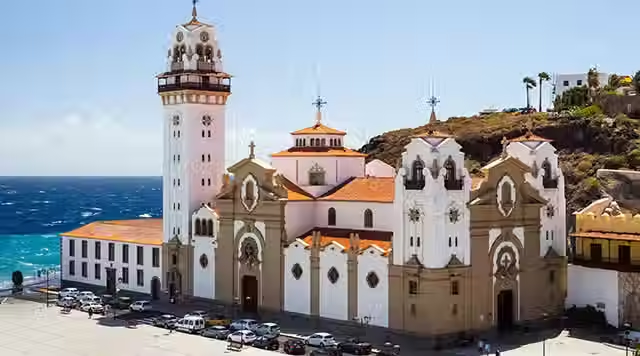

Basilica de la Virgen Candelaria
The Basilica of Candelaria is one of the most important places for the people of the Canary Islands. It is dedicated to the Virgen de la Candelaria, the patron saint of the Canary Islands, and is a much-loved site both for its history and its special atmosphere. It is located by the sea and has a beautiful design that mixes the traditional with more modern touches. Every 15th August it fills up with people who come on pilgrimage to celebrate the Virgin, in one of the biggest fiestas on the islands. It is also common to see visitors and locals strolling around the square, enjoying the views and the peaceful atmosphere. Also, right next to it are the famous statues of the Guanche menceyes, reminiscent of the ancient kings of Tenerife. It is a place that blends faith, culture and landscape, ideal to visit whether you are a believer or just want to get to know a place with history and good views.

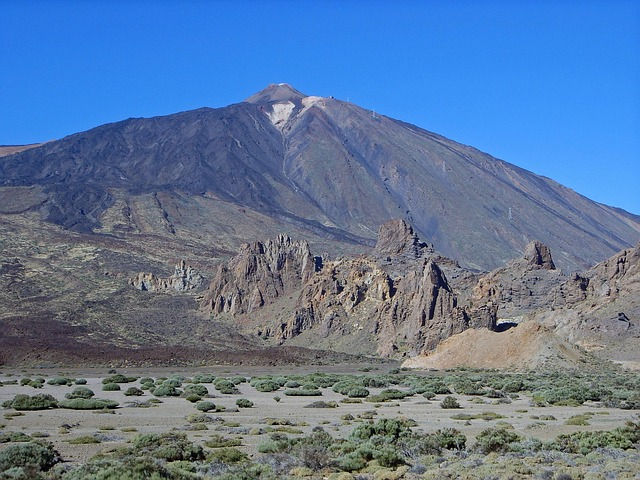


El Teide
The Teide volcano is the highest peak in the whole of Spain at 3,715 m above sea level and is the third highest volcano in the world from its base, after Mauna Loa and Mauna Kea in the Hawaiian Islands.




Santa Cruz De Tenerife
Santa Cruz, besides being the capital of the island, is a lively modern city that still retains historical corners of absolute beauty.




Mercado Municipal Nuestra Señora de África
The “Mercado Municipal Nuestra Señora de África” is a very characteristic place for its pretty architecture and the kind of products you can find there. It is definitely worth a visit to enjoy its colours and, if you want to taste wonderful fresh fish, its flavours too! A true dive into the origins of this island!






